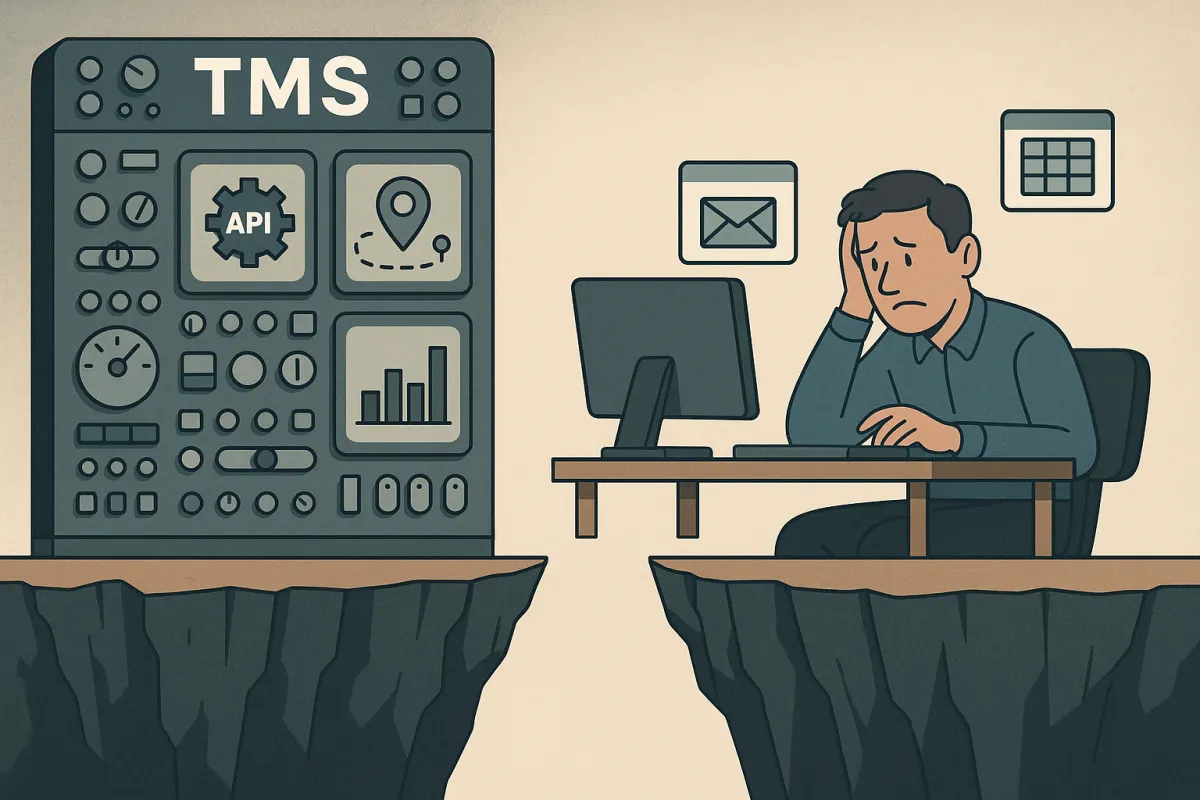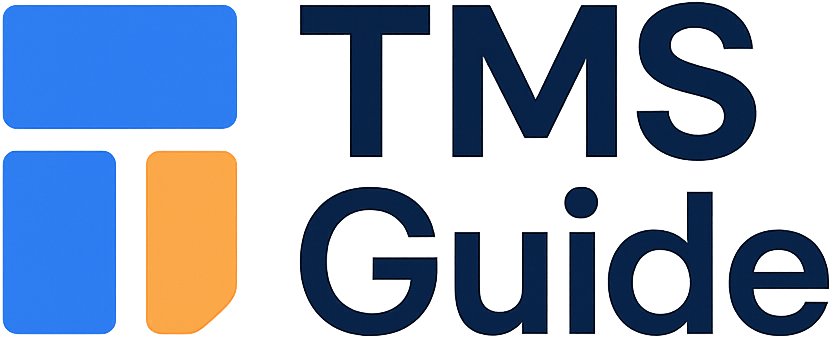Beyond Feature Lists: The Performance Metrics Every TMS RFP Should Include

Most TMS RFPs read like feature shopping lists. "Must support API integration." "Must have track and trace." "Must include reporting tools." Sound familiar? You tick boxes, compare spreadsheets, and wonder why the winning system still leaves your transport team juggling emails and Excel sheets six months later.
The problem isn't the features. The simple question 'how much does it cost to implement a shipper TMS?', can be answered with 'anything between 30,000 EUR and 900,000 EUR (33,500 USD and 1,000,000 USD)'. The fact that numerous elements influence these costs explains the wide range. But here's what most procurement teams miss: the gap between having a feature and getting value from it.
After twelve years running TMS selections and implementations on both the shipper and provider side, I've seen too many companies buy sophisticated systems that end up underused. The RFPs that deliver real results focus on performance metrics that predict whether users will actually adopt the system and whether it'll deliver measurable business value.
Why Traditional TMS RFPs Miss the Mark
Walk through any typical TMS RFP and you'll find sections like "System Requirements" filled with yes/no questions. Does the system support EDI? Does it offer multi-language capability? Does it integrate with SAP? The vendor checks all the boxes, you feel confident about coverage, and procurement calls it thorough.
But feature checklists tell you nothing about execution quality. Take carrier integration. Most RFPs ask "Does the system support carrier API connections?" The real question should be "How many of our current carriers are already live on your platform, and what's the average time to onboard a new one?"
A TMS without carrier coverage is a dashboard without data. Yet I've seen companies select systems that technically "supported" their carriers but took 4-6 months to get even basic connections working. Meanwhile, transport planners fell back to email and phone calls.
The same applies to user experience. RFPs ask about "intuitive interface design" without measuring what intuitive actually means for your team. Transport planners under time pressure will revert to email and Excel if the system isn't intuitive. You need metrics that predict whether real users will actually use the system when they're stressed and racing against pickup deadlines.
The Six Performance Metrics That Matter Most
Based on procurement cycles across industries from automotive to retail, six metrics consistently separate systems that deliver value from those that become expensive dashboards.
Carrier Network Depth and Onboarding Speed
How quickly and seamlessly can the TMS connect you to your carriers, and how many are already integrated? How to measure: % of your current carriers already live, average onboarding time for a new carrier.
Don't just ask for carrier names. Request specific integration details: how many of your top 20 carriers already have live API connections? For those without connections, what's the vendor's track record for new integrations? Best-in-class platforms can onboard new carriers in days, not months.
I've seen companies select vendors with impressive carrier networks only to discover their specific regional carriers weren't included. The vendor promised quick integration, but six months later they were still exchanging technical specifications. Ask for customer references who've onboarded similar carrier types in your geography.
Time-to-Value Implementation
European shippers often run procurement cycles under pressure. A 6–12 month rollout can already miss market shifts. How to measure: Average time (in weeks) to go live for a mid-sized customer with 10–20 carriers.
Forget generic implementation timelines. Ask for specific metrics: what's the average time from contract signature to first successful booking for companies similar to yours? Get references from customers with comparable complexity, not just the vendor's fastest deployment stories.
Cloud-native TMS players report 6–12 weeks vs legacy enterprise systems at 6–12 months. But speed isn't everything. Some rapid deployments achieve fast go-live by limiting functionality. Ask what percentage of planned features are typically live at go-live versus phased in later.
User Adoption Rates
A TMS is only as good as the people using it. Adoption is a leading indicator for ROI. How to measure: Post-implementation adoption (% of bookings actually made through the TMS), plus NPS/user satisfaction. Benchmarks: Look for >80% adoption within the first year.
User adoption metrics reveal whether the system actually fits your workflows. Ask vendors for adoption statistics from similar customers: what percentage of bookings flow through the TMS after 6 months? After 12 months? How many customers see adoption rates decline after the initial implementation period?
A successful adoption rate typically ranges from 60% to 70% of total users actively using the software by the end of the adoption period (usually the first 3-6 months). While these figures are not definitive benchmarks, they can provide a rough estimate of a successful adoption rate.
Don't accept vague promises about "user-friendly design." Request specific adoption metrics and reference customers who can speak to actual usage patterns, not just executive satisfaction.
Process Automation Levels
Every manual booking, track & trace call, or invoice check is cost leakage. How to measure: % of shipments auto-booked, % of invoices auto-matched, % of status updates automated. Benchmarks: The best-performing TMSs automate 50–70%+ of routine transactions.
Manual intervention is expensive and error-prone. Request automation metrics from the vendor's existing customer base: what percentage of routine tasks require human intervention? How much manual data entry is typical?
Some vendors claim full automation but define it narrowly. A system might auto-generate bookings but still require manual carrier selection, routing decisions, or rate confirmations. Ask for detailed breakdowns of what "automated" actually includes.
Data Accuracy and Real-Time Visibility
S&OP, inventory, and customer service depend on reliable ETAs. How to measure: Average latency of status updates (instant vs minutes vs hours), % of shipments with complete milestone data.
Poor data quality kills trust in any system. Ask about data refresh rates, milestone completion percentages, and accuracy of delivery estimates. How often do customers receive contradictory information between the TMS and direct carrier communications?
Real-time doesn't always mean better if it comes with accuracy trade-offs. Some systems prioritize speed over quality, pushing frequent but unreliable updates. Ask for specific metrics on data accuracy and how the vendor handles conflicting information from multiple sources.
Security and Compliance Requirements for European Shippers
The General Data Protection Regulation (GDPR) is a comprehensive data protection law that was implemented in May 2018 to safeguard the privacy rights of individuals within the European Union (EU) and the European Economic Area (EEA). Data residency, in the context of GDPR, refers to the requirement for organizations to ensure that the personal data they collect and process is stored and handled within specific geographic locations.
For European shippers, GDPR compliance isn't optional. Your RFP should include specific questions about data processing locations, breach notification procedures, and data subject rights management. Under GDPR, data residency is a critical aspect that requires organisations to store and process personal data within specific geographic locations or implement appropriate safeguards when transferring data across borders.
Ask vendors about their EU data centers, backup locations, and any circumstances under which data might be processed outside the EEA. Some cloud-based TMS providers use global infrastructure that may temporarily process data in non-EU locations, even if primary storage remains compliant.
Non-compliance with GDPR can result in fines of up to 4% of an organisation's global annual turnover or €20 million, whichever is higher. These penalties apply not only to data breaches but to any violation of the regulation's requirements, making comprehensive compliance essential for all organisations handling EU residents' data.
Total Cost of Ownership Framework
Cloud-based TMS platforms operate on subscription pricing, with user fees ranging from $50 to $500 monthly. User licensing makes up a significant portion of total TMS expenses. Most software providers use a per-user pricing model, with monthly fees ranging between $75 and $250 per person.
But user licensing is just the starting point. Basic API integrations typically cost between $5,000 and $15,000, while connecting with complex ERP systems might exceed $50,000. Single-day training sessions start at $1,500, while complete onboarding packages range from $10,000 to $30,000.
Build a TCO model that captures the full lifecycle costs. Include integration fees, customization costs, training expenses, and ongoing support. Factor in the hidden costs of poor adoption: if only 40% of your team uses the system effectively, you're essentially paying for unused capacity.
The average price of a TMS system varies from US$36K to US$150K within the first year, and from US$300K to US$1M within five years. The wide range reflects the different approaches vendors take to pricing and the varying levels of customization required.
Consider the trade-offs between initial cost and long-term value. Ready-made solutions require a fixed price for every unit connected to the system. This is why beginners get cheap and effective software that costs about US$36-40, 000 within the first year but in case of scaling, overall expenses may grow to US$900-1,000,000 in 5 years. As for custom systems, a business owner faces huge expenses from the beginning (US$130-150,000), but within other years, expenses increase slowly no matter how many units are connected to a TMS. For instance, in five years your company may spend just US$300-400,000 that is almost 70% lower than ready-made solutions demand.
Building Your Performance-Based RFP
Structure your RFP around outcomes rather than features. Instead of asking "Does the system support multi-stop routing?" ask "What percentage of your customers achieve better than 15% improvement in route efficiency within six months?" Instead of "Does the system provide reporting?" ask "How many standard reports do customers typically use regularly, and what's the average time to generate custom reports?"
Include reference requirements that tie to your metrics. Don't just ask for customer names; specify that you want to speak with customers who have similar carrier mixes, shipment volumes, and operational complexity. Ask references about actual adoption rates, implementation timelines, and ongoing support quality.
Weight your scoring to emphasize performance metrics over feature counts. A system that delivers 85% user adoption with 50 features will outperform one with 200 features but 40% adoption. Build your evaluation criteria to reflect this reality.
Consider vendors across the spectrum. There are several credible options in the European market: Transporeon (long-standing network with deep carrier integrations) Alpega (strong for multi-national complex shippers) Blue Yonder (enterprise supply chain suite with TMS component) Oracle NetSuite/Infor/SAP modules (robust & expensive but slower to deploy) Cargoson (cloud-native, lighter-weight and fast to onboard, gaining popularity among mid-sized European manufacturers, but not suitable for 3PL/4PL and is still a young company)
Sample RFP Questions That Reveal Performance
Replace generic feature questions with performance-focused alternatives:
- Instead of: "Does the system support carrier integration?" Ask: "What percentage of European LTL carriers in our current mix are already live on your platform? What's your average onboarding time for carriers not in your network?"
- Instead of: "Does the system provide real-time tracking?" Ask: "What's the average delay between a status change at the carrier and an update in your system? What percentage of shipments receive complete milestone data?"
- Instead of: "Is the system user-friendly?" Ask: "What percentage of users complete their first booking without support assistance? What's your average user adoption rate at 6 months post-go-live?"
- Instead of: "Does the system support our ERP?" Ask: "How many customers have implemented your SAP connector? What's the typical timeline from contract to live data exchange?"
Include performance guarantees in your contracting discussions. Some vendors will commit to adoption rate targets, implementation timelines, or integration completion schedules. These commitments reveal confidence in their execution capabilities.
The shift from feature-based to performance-based procurement isn't just about better vendor selection. It changes how you think about TMS value and sets clear expectations for what success looks like. The point of an RFP is not to crown a "winner" from the start. Instead, these metrics let you compare apples with apples. And while some vendors excel in network depth, others in usability or agility, the subtle differentiator often comes down to how fast and painlessly you can actually get to value.
Focus on metrics that predict real-world success. Your transport team will thank you when they're actually using the system instead of working around it.





